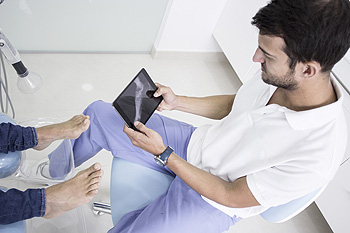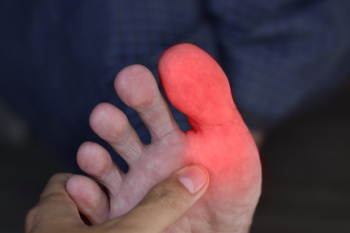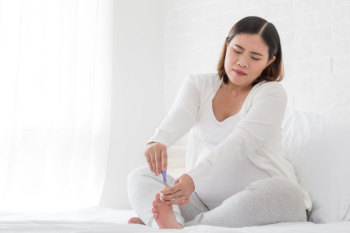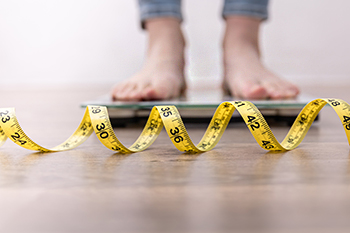Items filtered by date: April 2024
The Path to Podiatry

Becoming a podiatrist involves a journey of dedication and specialized training, starting with undergraduate studies in a science-related field. After completing a bachelor's degree, aspiring podiatrists pursue a Doctor of Podiatric Medicine, or DPM, degree, typically a four-year program focused on foot and ankle anatomy, biomechanics, and medical and surgical interventions. Throughout their education, students engage in clinical rotations to gain hands-on experience in diagnosing and treating foot and ankle conditions. After graduating, podiatrists often undertake residencies to further refine their skills in areas such as surgery, sports medicine, or wound care. Finally, they obtain licensure to practice independently. Transitioning from student to professional, podiatrists continue to expand their knowledge through continuing education and staying abreast of advancements in podiatric medicine. If you are experiencing foot or ankle discomfort, it is suggested that you seek the expertise of a podiatrist for an accurate diagnosis and effective treatment.
If you are dealing with pain in your feet and ankles, you may want to seek help from a podiatrist. Feel free to contact one of our podiatrists from Nola Sole Podiatry. Our doctors can provide the care you need to keep you pain-free and on your feet.
What Is a Podiatrist?
A podiatrist is a doctor of podiatric medicine who diagnoses and treats conditions of the foot, ankle, and related structures of the leg. Your podiatrist may specialize in a certain field such as sports medicine, wound care, pediatrics, and diabetic care. Podiatrists have the ability to become board certified through training, clinical experience, and then taking an exam.
What Do Podiatrists Do?
On a daily basis, a podiatrist may perform the following activities:
- Diagnose foot ailments such as ulcers, tumors, fractures, etc.
- Use innovative methods to treat conditions
- Use corrective orthotics, casts, and strappings to correct deformities
- Correct walking patterns and balance
- Provide individual consultations to patients
It is very important that you take care of your feet. It’s easy to take having healthy feet for granted, however foot problems tend to be among the most common health conditions. Podiatrists can help diagnose and treat a variety of feet related conditions, so it is crucial that you visit one if you need assistance.
If you have any questions please feel free to contact our office located in New Orleans, LA . We offer the newest diagnostic and treatment technologies for all your foot and ankle needs.
Podiatric Insights Into Sesamoiditis Treatment

Sesamoiditis is characterized by inflammation or injury to the sesamoid bones, small bones located beneath the big toe joint in the foot. It commonly affects individuals involved in activities that put repetitive pressure on the ball of the foot, such as dancers, runners, or those who wear high heels. The condition can cause pain, swelling, and difficulty walking, particularly when bearing weight on the affected foot. Diagnosis typically involves a physical examination, imaging studies like X-rays or MRI scans, and evaluation of symptoms. Treatment options may include rest, taping of the foot, orthotic devices, or corticosteroid injections. In severe cases, surgery to remove or repair the sesamoid bone may be necessary. If you have big toe pain, it is suggested that you schedule an appointment with a podiatrist for a tailored treatment plan for your specific needs.
Sesamoiditis is an unpleasant foot condition characterized by pain in the balls of the feet. If you think you’re struggling with sesamoiditis, contact one of our podiatrists of Nola Sole Podiatry. Our doctors will treat your condition thoroughly and effectively.
Sesamoiditis
Sesamoiditis is a condition of the foot that affects the ball of the foot. It is more common in younger people than it is in older people. It can also occur with people who have begun a new exercise program, since their bodies are adjusting to the new physical regimen. Pain may also be caused by the inflammation of tendons surrounding the bones. It is important to seek treatment in its early stages because if you ignore the pain, this condition can lead to more serious problems such as severe irritation and bone fractures.
Causes of Sesamoiditis
- Sudden increase in activity
- Increase in physically strenuous movement without a proper warm up or build up
- Foot structure: those who have smaller, bonier feet or those with a high arch may be more susceptible
Treatment for sesamoiditis is non-invasive and simple. Doctors may recommend a strict rest period where the patient forgoes most physical activity. This will help give the patient time to heal their feet through limited activity. For serious cases, it is best to speak with your doctor to determine a treatment option that will help your specific needs.
If you have any questions, please feel free to contact our office located in New Orleans, LA . We offer the newest diagnostic and treatment technologies for all your foot care needs.
Wounds That Don't Heal Need to Be Checked
How Ingrown Toenails Develop
 Ingrown toenails occur when the edge of a toenail, most commonly on the big toe, grows into the surrounding skin. This can lead to pain, redness, swelling, and sometimes infection. This common foot issue can be caused by improper nail trimming, like cutting the nails too short or not straight across. Tight-fitting shoes that press the nail into the toe skin, injury to the toenail, or genetics that predispose someone to curved nails can also contribute to ingrown toenail development. Ingrown toenails can be a cause for concern, especially if they happen frequently or lead to severe pain and infection. If not properly treated, the infection can spread and pose serious health risks, particularly for people with diabetes or poor circulation. Early treatment and certain preventive measures, like proper nail care and wearing appropriately fitting shoes, can help avoid complications. If you have an ingrown toenail, it is suggested that you consult a podiatrist for professional treatment and prevention of further issues.
Ingrown toenails occur when the edge of a toenail, most commonly on the big toe, grows into the surrounding skin. This can lead to pain, redness, swelling, and sometimes infection. This common foot issue can be caused by improper nail trimming, like cutting the nails too short or not straight across. Tight-fitting shoes that press the nail into the toe skin, injury to the toenail, or genetics that predispose someone to curved nails can also contribute to ingrown toenail development. Ingrown toenails can be a cause for concern, especially if they happen frequently or lead to severe pain and infection. If not properly treated, the infection can spread and pose serious health risks, particularly for people with diabetes or poor circulation. Early treatment and certain preventive measures, like proper nail care and wearing appropriately fitting shoes, can help avoid complications. If you have an ingrown toenail, it is suggested that you consult a podiatrist for professional treatment and prevention of further issues.
Ingrown toenails can become painful if they are not treated properly. For more information about ingrown toenails, contact one of our podiatrists of Nola Sole Podiatry. Our doctors can provide the care you need to keep you pain-free and on your feet.
Ingrown Toenails
Ingrown toenails occur when a toenail grows sideways into the bed of the nail, causing pain, swelling, and possibly infection.
Causes
- Bacterial infections
- Improper nail cutting such as cutting it too short or not straight across
- Trauma to the toe, such as stubbing, which causes the nail to grow back irregularly
- Ill-fitting shoes that bunch the toes too close together
- Genetic predisposition
Prevention
Because ingrown toenails are not something found outside of shoe-wearing cultures, going barefoot as often as possible will decrease the likeliness of developing ingrown toenails. Wearing proper fitting shoes and using proper cutting techniques will also help decrease your risk of developing ingrown toenails.
Treatment
Ingrown toenails are a very treatable foot condition. In minor cases, soaking the affected area in salt or antibacterial soaps will not only help with the ingrown nail itself, but also help prevent any infections from occurring. In more severe cases, surgery is an option. In either case, speaking to your podiatrist about this condition will help you get a better understanding of specific treatment options that are right for you.
If you have any questions, please feel free to contact our office located in New Orleans, LA . We offer the newest diagnostic and treatment technologies for all your foot care needs.
Excess Weight Can Cause Foot Pain

Foot pain resulting from obesity can profoundly affect biomechanics and gait, as excess weight places undue stress on the feet, ankles, and lower limbs. This strain can alter the way you walk, leading to compensatory movements and further discomfort. Beyond physical discomfort, foot pain caused by obesity can significantly impact daily life, hindering mobility and limiting participation in activities. Seeking help from a podiatrist offers compassionate support and effective solutions for anyone suffering foot problems related to their weight. Podiatrists understand the complexities of foot pain associated with obesity and can provide personalized care to address your unique needs. They offer a range of treatments, including orthotic devices to support proper alignment and footwear guidance to alleviate pressure. If you carry excess weight and have foot pain, it is suggested that you schedule an appointment with a podiatrist so you can embark on a journey toward improved foot health and enhanced overall well-being.
Obesity has become very problematic at this point in time and can have extremely negative effects on the feet. If you’re an obese individual and are concerned about your feet, contact one of our podiatrists from Nola Sole Podiatry. Our doctors can provide the care you need to keep you pain-free and on your feet.
Obesity and Your Feet
Since your feet are what support your entire weight when standing, any additional weight can result in pain and swelling. Being overweight is one of the main contributors to foot complications.
Problems & Complications
Extra Weight – Even putting on just a few extra pounds could create serious complications for your feet. As your weight increases, your balance and body will shift, creating new stresses on your feet. This uneven weight distribution can cause pain, even while doing the simplest tasks, such as walking.
Diabetes – People who are overweight are at serious risk of developing type-2 diabetes, which has a drastic impact on the health of your feet. As you get older, your diabetes might worsen, which could lead to loss of feeling in your feet, sores, and bruises. You could also become more prone to various infections.
Plantar fasciitis – Pressure and stress that is placed on muscles, joints, and tendons can trigger plantar fasciitis, which is an inflammation of tissue that forms along the bottom of the foot.
If you have any questions please feel free to contact our office located in New Orleans, LA . We offer the newest diagnostic and treatment technologies for all your foot and ankle needs.
Foot Hygiene and Athlete’s Foot

Athlete's foot is a common fungal infection of the skin, typically occurring between the toes. It thrives in warm, moist environments such as locker rooms, swimming pools, and communal showers. Poor hygiene, sweaty feet, and wearing tight, non-breathable shoes can increase the risk of infection. Prevention primarily revolves around maintaining good foot hygiene practices, including washing and thoroughly drying feet daily, especially between the toes. Wearing clean socks made of breathable materials and changing them regularly can also help prevent fungal growth. Additionally, avoiding walking barefoot in public places and wearing protective footwear in communal areas can reduce exposure to the fungus. Podiatrists play a vital role in treating athlete's foot, offering antifungal medications in various forms, such as creams, powders, or oral medications, depending on the severity of the infection. They may also give guidance on proper foot hygiene and preventive measures to minimize the risk of recurrence. If you have developed athlete’s foot, it is suggested that you visit a podiatrist who can offer you the appropriate treatment method.
Athlete’s Foot
Athlete’s foot is often an uncomfortable condition to experience. Thankfully, podiatrists specialize in treating athlete’s foot and offer the best treatment options. If you have any questions about athlete’s foot, consult with one of our podiatrists from Nola Sole Podiatry. Our doctors will assess your condition and provide you with quality treatment.
What Is Athlete’s Foot?
Tinea pedis, more commonly known as athlete’s foot, is a non-serious and common fungal infection of the foot. Athlete’s foot is contagious and can be contracted by touching someone who has it or infected surfaces. The most common places contaminated by it are public showers, locker rooms, and swimming pools. Once contracted, it grows on feet that are left inside moist, dark, and warm shoes and socks.
Prevention
The most effective ways to prevent athlete’s foot include:
- Thoroughly washing and drying feet
- Avoid going barefoot in locker rooms and public showers
- Using shower shoes in public showers
- Wearing socks that allow the feet to breathe
- Changing socks and shoes frequently if you sweat a lot
Symptoms
Athlete’s foot initially occurs as a rash between the toes. However, if left undiagnosed, it can spread to the sides and bottom of the feet, toenails, and if touched by hand, the hands themselves. Symptoms include:
- Redness
- Burning
- Itching
- Scaly and peeling skin
Diagnosis and Treatment
Diagnosis is quick and easy. Skin samples will be taken and either viewed under a microscope or sent to a lab for testing. Sometimes, a podiatrist can diagnose it based on simply looking at it. Once confirmed, treatment options include oral and topical antifungal medications.
If you have any questions, please feel free to contact our office located in New Orleans, LA . We offer the newest diagnostic and treatment technologies for all your foot care needs.

